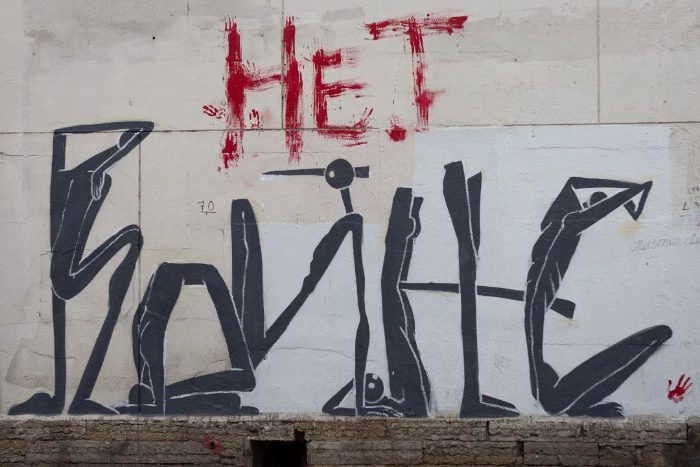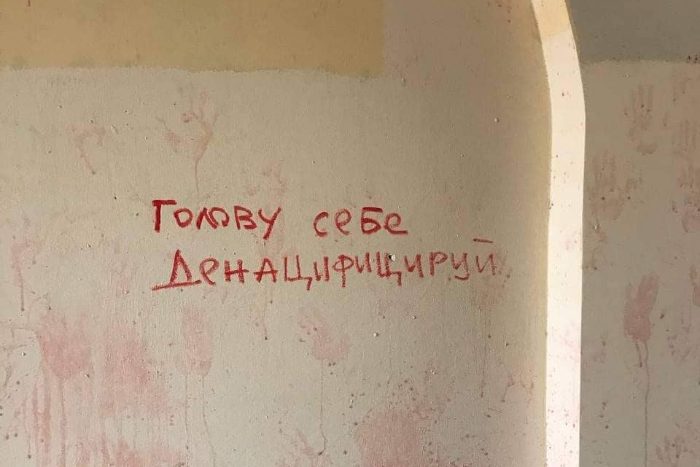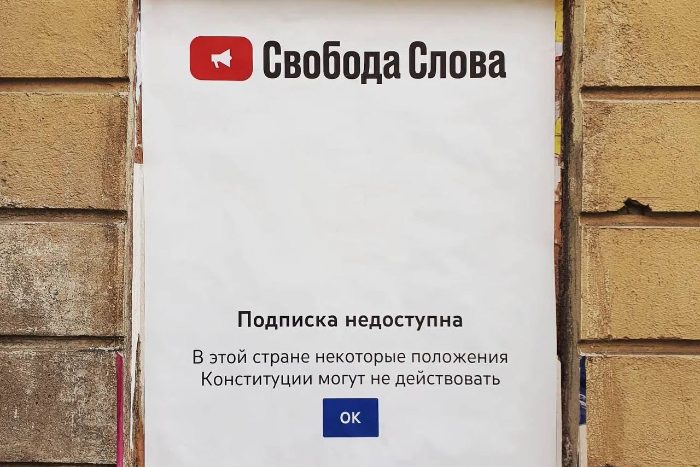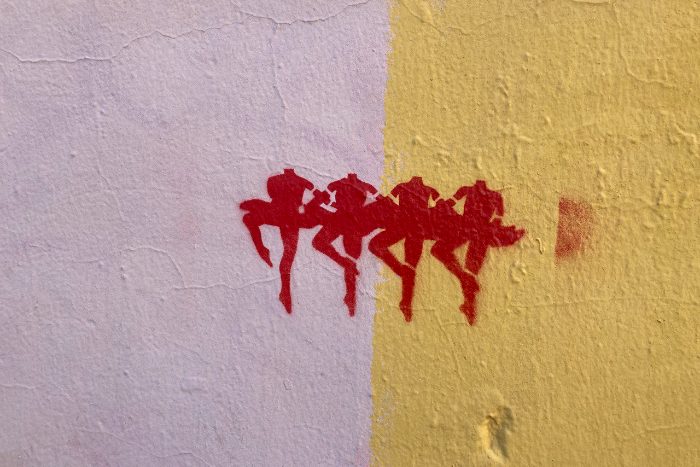The space of public discussion in Russia has shrunk dramatically after the invasion into Ukraine. Street protests that took place almost daily in Saint Petersburg and other cities at the end of February were suppressed even more brutally [For instance, Andrei Ivanov was violently beaten up by the police at a protest on March 6 in Saint Petersburg. The police kept him in detention for several hours, refusing to call an ambulance.] than before. Over 12 thousand people were detained across the country over the first two weeks of protests.
It was during the same time that anti-war messages began appearing in the streets of Russian cities in the form of graffiti, stickers, murals and posters. Street art in various forms has become the most visible anti-war phenomenon.
Paperpaper.ru has talked to creators of street messages about their intended audience and safeguard measures they take and reached out to experts to appraise the developments in protest street art in Saint Petersburg.

How did writing on walls become a mass phenomenon in Saint Petersburg
“It’s difficult to estimate at this point, but I made a few hundred graffitis and posted a couple hundred of paper stickers,” says Aleksei (all names in this story have been changed to protect our sources’ safety), a film critic from Saint Petersburg who distributed anti-war messages in the city streets. After February 24, he went for occasional nighttime strolls as his wish to speak out and express his emotions became stronger while the usual methods to do so were dangerous and inefficient, unable to reach those who trusted propaganda or pretended nothing was happening.
The Saint Petersburg resident thinks that people tend to believe anything if they feel that’s what everyone else believes. That is why it’s important for Aleksei to remind the others about an alternative view of current events.
Anastasia, who works as a translator, agrees that there is no other way left in Russia to safely express dissent. She attended street protests, but each subsequent rally had fewer demonstrators and more riot police.
In her free time, Anastasia teamed with her friend to post DIY stickers, made of paper and double-sided adhesive tape, around the city. They pasted up their messages on downpipes, walls and transformer boxes. The women began with distributing facts about the war, but, after the case against Sasha Skochilenko, decided to avoid “propagating fake news” in favor of “discrediting our army” [Anastasia is referring to the two new articles of Russia’s Criminal Code, introduced after the beginning of the invasion: “public distribution of knowingly false information about use of the Russian Armed Forces, or about lawful actions by the Russian Federation’s civil authorities” (article 207.3), and “public actions aimed at discreditation of the Russian Armed Forces” (article 280.3).
The latter carries a lighter punishment: civil prosecution can only follow a misdemeanor charge under the identically worded article 20.3.3 of the Administrative Offense Code.] with anti-war slogans.
The young woman believes that such messages are a way to resist normalization of war and public indifference to it, as well as to support opinion allies: every graffiti, poster and green ribbon (a symbol of the anti-war movement) are reminders that there are many dissenters around and that not all has been lost.
Anastasia and her friend did not experience any aggression connected to their activity, nor were there any attempts to arrest them; the woman attributes it to their being cautious. She has fled Russia now but lived under stress until her departure, fearing that the police could use CCTV cameras to identify and find her.
Another Saint Petersburg man, Dmitry, told us he had had about thirty or forty unused paint spray bottles left after repairs in the cafe he owns and figured that anti-war graffiti was an efficient way to get out an anti-war message. Dmitry says that as many people will see graffiti as an official poster with a Georgian ribbon and a Z sign [Militaristic symbols promoted by the Russian authorities]. He posted a picture of the leftover spray bottles on his personal online account with a caption “You know what to do.” He handed out the paints over just a few days.
Engineer Vasily says he posted about fifteen stickers because he felt compelled to take some action. In his opinion, an anti-war message is effective if it convinces even one person who would then convince someone else. He says that stickers are practical and safe because it takes so little time to paste and unpaste one. Vasily was less afraid of the police than of the “seventy percent” of Russians supporting the war: he was nervous he could get his “ass kicked by a pro-Russian passer-by.”

How street art can influence society and politics ↓
“Art always aligns with revolution,” says Anton Polsky, a practitioner and researcher of street and performance art.
Many people in the history of art were committed to make a difference in society and politics through their artworks. Leftist artists have made projects with an urban agenda, such as Reclaim the Streets [Actionists of Reclaim the Streets movement invented theatricalized ways to block highway traffic: for instance, suspending a person at the top of a six-meter tripod that obstructs movement of cars without interfering with pedestrian flow. Knocking the tripod over would mean making the suspended person fall to the ground, which meant the police or the drivers couldn’t do anything. After a road was blocked, thousands of people, who had come out to a designated place in advance, would pour out into the street and begin a rave. The road would be declared “an open street” complete with road signs like “breathing is allowed”, “car-free zone” and “reclaim the space”. In some cases, large sand-pits and swing sets, inflatable pools, couches, carpets and volleyball nets were installed at a crossroads.] and Provo.
Provo was a robust art movement in Amsterdam in the 1960s that objected to the existing lifestyle in the Netherlands and their parents’ bourgeois values, says Anton Polsky. For instance, they criticized automobilization of Amsterdam and literally invented bicycle sharing as an alternative, distributing hundreds of white bikes around the city for anyone to use. They also proposed a number of so-called “white plans” [E.g. the White Wives plan to create a network of sexual health and reproduction planning centers, and to introduce sex education in high schools. Or the White Chicken plan to disarm the Amsterdam police (nicknamed “the blue chicken”); the plan also proposed that the police use white bicycles for moving around, provide first aid and give out condoms and fried chicken.]. Polsky points out Provo’s use of humor and irony, in contrast to judgemental, all-or-nothing attitudes pervading traditional political struggle.
Another example, Polsky says, is the Orange Alternative art movement that emerged in the 1980s’ Poland, most notably in Wroclaw. Inspired by Provo, the movement’s members actively used irony and absurdism to protest against the Communist regime in Poland. According to the art historian, the Orange Alternative proved the efficiency of resisting the power with trolling, provocation and playfulness.
What are the messages that people leave on walls
Tour guide Nikolai, known professionally as Steklotour, has been compiling unusual anti-war signs on walls since the beginning of the war. His collection now includes over a hundred. “In the first few days of the war I tried to record every graffiti I noticed but soon realized it was impossible.”
Nikolai says that “no to war”, “peace for the world”, peace signs and green ribbons are the most frequent protest signs. Some of the more original messages are “don’t give in to evil” and “make love not war.” The number of anti-war graffiti has increased over time without losing in quality, the street art hunter adds.
Art historian and member of the Street Art Research Institute Dmitry Pilikin says he has amassed over three hundred photographs of anti-war street art. In addition to items from Nikolai’s collection, he mentions “fuck war”, the laconic “peace” and more original slogans: “Leningrad won’t go Nazi” with the Z letter highlighted; “silence is crime”; “man is another man’s human” [A reference to the idiom “man is another man’s wolf”, i.e. “dog eat dog”.]; “we’re Russians, God-knows-what is on our side”; “denazify your head first” [“Denazification” of Ukraine was among the war’s objectives declared by Vladimir Putin; the Kremlin never clarified what exactly it meant.]; “the Hague is waiting”; “the force is [measured] in Newtons” [An ironic reference to the famous quote from the film Brother 2, “The force is in truth” (or “The strength is in truth”), coopted by Russian propaganda during the war.].
Anti-war artworks have very different lifespans. Anastasia Vladychkina, a member of the Yav Art Collective, told Paperpaper.ru that their latest works had barely lasted for two hours. The street artist Vlada MV says the average lifespan of her anti-war works is one day.
Dmitry Pilikin explains that the amount of time that a street artwork can last before it’s destroyed depends on the location (hidden or in open view), and on jurisdiction over a building. Nikolai Steklotour says that anti-war graffiti, like any street art, can last for any amount of time from two days to two weeks. Importantly, a new graffiti or a couple emerge for each one that’s painted over.
Researchers and artists agree that there is much more graffiti against the war than in support. During his tour around the Ligovsky Avenue area, Nikolai suggested to the excursionists that they count all the writings and compare the numbers. They found only six graffiti in support of the war (Z letters, “we don’t abandon our own” [one of the war’s mottos promoted by propaganda], a heart in Russian flag’s colors with a Z inside), compared to 34 anti-war signs and messages.
Yav Art Collective’s leader Anastasia Vladychkina says that, in March, many stencil images of the president and the Z letter appeared around the city. However, she adds, graffiti of this kind was most often amended by passers-by, who would, for instance, add more letters to the Z, transforming the militaristic symbol into an obscene word or a ridiculous slogan.
In Nikolai Steklotour’s opinion, the main difference is that anti-war protest is diverse in form and content, whereas militaristic graffiti are “cut-and-dried, made to the party’s order.”
Dmitry Pilikin does not believe that the state is interested in seizing the initiative in street art. Those hooked up to television don’t need an extra stimulus, and the others are comfortable with radio silence [Military censorship limiting freedom of expression].

How the authorities respond to street art protest
Graffiti makers are wrong when they assume it is a safe way to protest. We have no statistics of criminal cases for writing on walls, however, Paperpaper.ru found mentions of at least 20 investigations concerning anti-war street art.
At least eight of those are in Saint Petersburg. One case was initiated against Yegor Kazanets, charged with vandalism motivated by political hatred for writing “Glory to Ukraine!” on an apartment building’s facade. Another Saint Petersburg man, Sergei Vasiliev, was sent to detention center under similar charges because of the words “Glory to Ukraine! Glory to the heroes!” on a public sliding board for children. A 43-years-old engineer is prosecuted for allegedly painting on a Soviet-era monument sign at Polezhaevsky public park; OVD-info reported on one more person detained for anti-war graffiti.
Dmitry Kh., also from Saint Petersburg, was jailed for allegedly writing “No to war” and “Putin is a fascist” on a Soviet soldiers memorial; the police invoked the criminal code’s article on “desecration of grave motivated by political hatred.”
Two persons, according to the police, painted cannon shields of two weapons, exhibited near the Artillery Military Museum, in blue and yellow. One of the alleged perpetrators was arrested on March 19 and charged with vandalism, while the second person’s identity remains unknown.
At least five people in Saint Petersburg were charged with the misdemeanor of “discrediting authority” for anti-war graffiti. Anna Ziv was fined 30 thousand roubles for a message she left on a bus stop pavilion, while Sergei Davydov received the same penalty for writing on a dumpster. Demian Bespokoev was fined for wearing an overcoat in public with an anti-war message written on it.
Sergei Malinovsky was sentenced to a fine for projecting an anti-war message onto a building wall. Teacher Yekaterina Vasilieva’s offense was having a sticker “No to war #silentprotest” attached to her backpack. Another Saint Petersburg citizen was fined for the words “No to war” on his bag, which was interpreted as “discrediting the army” by the police and in court.
What else citizens do to express dissent
The most common slogans found in the streets, like “No to war”, are likely the work of people who never made graffiti before. It is probably their way to resist and express their opinion, the art historian Dmitry Pilikin believes.
In addition to simple graffiti, dissenters make stickers and murals and use practices similar to “partisaning” [A street art movement based on the idea of using free artistic expression to transform urban environments by citizens themselves.
As a grassroots movement, partisaning is often illegal, and particular initiatives within it do not get submitted for approval to administrative offices or other institutions. Partisaning provides a way to identify local problems arising from unaddressed demands of the residents: a need of a pedestrian crossing or a bicycle track, a lack of road signs or benches, etc.
The methods of partisaning are close to sociology and urban studies as it is often grounded in preliminary research of a chosen neighborhood, street, or public yard.], like the #silentprotest (#tihiipiket) and other creative ways to protest, according to the researcher Anton Polsky.
Dmitry Pilikin says that the idea to replace supermarket price tags with anti-war messages [There have been several criminal investigations in Russia connected to replacing price tags, and a few more people have been fined for this.
Criminal charges were brought against Sasha Skochilenko in Saint Petersburg and Vladimir Zavialov in Smolensk, citing the new article on distributing false information about the Russian army.
A student in Nizhny Novgorod was charged with two counts of misdemeanor. The police say the young woman replaced price tags at Spar and Pyaterochka chain stores with leaflets that said “Weekly inflation has reached maximum since 1998 because of the military action in Ukraine. Stop the war.”
Furthermore, Andrei Makedonov was detained in Saint Petersburg. It was reported that the man replaced price tags at a supermarket with leaflets saying “No to war.” There have been no further reports about his case.] is an elegant way of artistic intervention. Another example of that cited by Pilikin is posting colorful stickers with anti-war messages resembling the ubiquitous sex worker ads.
There are also original works made by prominent street art groups or anonymously, Pilikin adds. Among those are works by Yav, cemetery performance by the Party of the Dead, the Tiny Protest (small human figures holding protest signs scattered across the city), and Zhenya Isayeva’s anti-war performance near the City Duma Building.

How street artists joined in on the protest
Anton Polsky says that the street art community’s activity increased after the invasion. Artists created group chats to discuss their participation in the resistance, and there has been a certain upsurge in political street art. Some would just write “No to war”, while others prepared original, less straightforward works.
Dmitry Pilikin disagrees. In his estimation, there are few elaborate and sophisticated works, because street artists fear persecution. Before the war, being mistaken for a drug dealer by passers-by and the police was the worst thing that could happen to street artists, whereas now their work has become criminalized.
Paperpaper.ru talked to four artists, all of whom emphasize that street art has always been their way to respond to current events. Artist Lyosha Burston created a series of works titled “Picket” as a response to the ban on public protesting, depicting a person holding an anti-war picket sign.
Vlada, another street artist, says that her first anti-war work was improvised in a hurry. “That was the fourth day of the war and I thought it was going to end soon.” Vlada paints human-like figures that form words like “war”, “power”, “Russia”, “our own”, or the Russian abbreviation “HV”, which may stand for “Christ is risen” or “Fuck war”.
Vlada says she has made preparations to leave the country in the case of persecution. Artists interviewed by Paperpaper.ru admit being nervous about their freedom and safety but keep openly posting their new work on social media, which means that it wouldn’t be difficult for the police to find them. Lyosha Burston adds that this feeling was the subject of his second work in the “Picket” series: “It’s about being tired and wishing you had someplace to sit down in quiet, but also you’re tired of fearing prison.”
Street artist FILIPP FI2K told Paperpaper.ru he had consulted with several people before making his murals and decided they were safe from a legal point of view. He painted a hare with a peace sign on it, chased by two dogs. FILIPP FI2K says he didn’t write up a description, except for the title “Chasing Peace”, and left it to the viewer to figure out what he meant. “Everyone can guess what the dogs stand for, why are they running and what will be the consequences if they get up to peace.”
Like other artists, FILIPP FI2K tried to remain unnoticed when making the mural. He prepared his stencils in advance and added the peace sign at the very end, so that the work wouldn’t seem like an anti-war statement until the last moment. Other artists describe similar techniques: for instance, Lyosha Burston paints a person with an empty sign before adding an anti-war slogan. Burston purposefully created monochrome designs, which would take no longer than twenty minutes to paint.
Vlada usually takes a friend to accompany her, who looks out for passers-by and the police. Her first “No to war” graffiti took about two hours to complete. Several patrol cars passed by while she was working; the police would slow down and leave after scaring the artists away. Vlada explains that it was hard to make out the words in the work-in-progress, the letters were not very legible, and the word “no” was only added at the end.
Yav Art Collective’s Anastasia Vladychkina also mentions additional safety measures. The group switched over to posters and media art, fearing that they wouldn’t be able to finish a mural. They paste up banners onto advertisement columns, choosing empty slots so as not to damage private property or cover advertisements. The process only takes 10 to 15 minutes to complete.
Producing the banners turned out to be a challenge, too. Several print shops that Yav’s members used to work with refused to print a poster about freedom of speech. Ultimately, they managed to find a service that “didn’t care at all” about what was being printed.
All the artists agree that it is still possible to make street art if it’s not “straightforward”.

Why street art emerged as the main way to express protest
Street art is impossible to censor, it’s anonymous and relatively safe: this is an average of artists’ and experts’ responses to Paperpaper.ru.
“When someone goes on a picket protest, the police pick them up right away, so nobody sees the protest, unlike graffiti,” says Yav’s Anastasia Vladychkina. FILIPP FI2K adds that it takes about five seconds to write “No to war” with spray paint. One spray bottle has enough paint for 50 to 100 signs like this, he goes on. He says that one person with one box of paints can “cover the whole city,” and painting skills aren’t necessary.
Researcher Anton Polsky thinks that mass street rallies in Russia don’t work for two reasons. First, riot police quickly break up rallies without giving time for the rallies to become a meeting point or a space for political action. The second reason is the bubble effect: people who go out to rallies already agree with each other, whereas it’s necessary to reach strangers and to find a safe way of communicating with them. Street art provides just such a way, providing an opportunity to leave the bubble and send a creative message.
Saint Petersburg is “a cranky city” (i.e. dirty and deteriorating), Polsky says: such places often prove a fertile ground for grassroots political street art.
Street art is universally accessible and free of institutional checks and restraints. Theaters, conservatories and art galleries did not respond to the war as massively and loudly due to being directly or indirectly dependent on the state.
Theater critic and blogger Viktor Vilisov explains: Russia’s art scene “is heavily dependent on public and quasi-public funding,” which is why even opponents of the war are afraid to publicly express their objections and risk employment regardless of their status. According to the critic, a widespread attitude among leaders of many theaters and contemporary art galleries is saying they must protect their institution from closing down by keeping silent or only making “obscure” statements.
There is a prevailing notion in Russia that art mustn’t interfere in politics, adds Anastasia Vladychkina from Yav. Artists are supposed to deal with eternal values: love, death, abstract philosophical concepts.
Anton Polsky thinks that street art in Russia could experience another upswing, like it did during the 2008 economic crisis. Back then, sales had slumped at the art market and street art grew more political. There is an important difference, however: at the time it was safe to openly paint on building walls, whereas now this could be punished by up to fifteen years of prison.
Paperpaper.ru — is independent media from Saint-Petersburg, Russia. We’ve been reporting on the Russian-Ukrainian war since the day it started. As a result, our website was blocked by the Russian government.
For 10 years we’ve been writing about the local community, business and initiatives. Yet, our main goal was always to improve life in the city we love.
We are Russian-language media but now we translate our the most significant articles to share it with our English speaking audience. Help independent journalism — save the freedom of speech!
